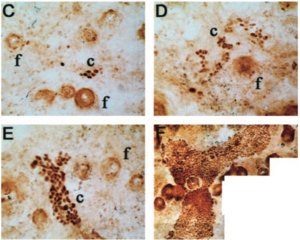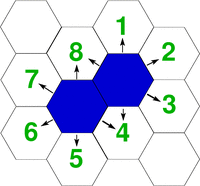
Stained p53-mutant cells (dark brown) in
mouse epidermis, from Zhang et al 2001.
| We created a computer model for simulating the growth of a pre-cancerous
lesion (or a tumor) on a surface, such as skin.
We used data from Zhang et al 2001 to test the model.
In that study, mice were exposed to moderate doses of ultraviolet radiation
(UVB) to mimic sun exposure.
It is believed that UVB has the following effects on the skin:
- UVB causes characteristic p53 mutations that inactivate the protein.
- UVB causes cells to undergo cell death (apoptosis).
- p53-mutant cells are resistant to UVB-induced cell death.
UVB can create p53-mutant cells while
killing surrounding normal cells,
which gives the mutants room to replicate.
Therefore, clones of p53 mutants tend to grow over time under prolonged exposure to UVB.
p53 mutants in skin can be detected by staining, as shown in the figure to the left.
|

